| Article ID | Journal | Published Year | Pages | File Type |
|---|---|---|---|---|
| 4713013 | Journal of Volcanology and Geothermal Research | 2016 | 13 Pages |
•Lake Rotomahana cores show < 129 years of post-eruptive lake sedimentation.•Light grey silt derived from loose pyroclastic deposits was washed into the lacustrine basin.•Lake sedimentation later stabilised to form a dark diatomaceous silt across the lake floor.•The upper layer is absent around hydrothermal vents and surrounding sediments are altered.•Silica extracted from pore water has precipitated as microspheres within the sediments.
Young volcanic lakes undergo a transition from rapid, post-eruptive accumulation of volcaniclastic sediment to slower pelagic settling under stable lake conditions, and may also be influenced by sublacustrine hydrothermal systems. Lake Rotomahana is a young (129 year-old), hydrothermally-active, volcanic lake formed after the 1886 Tarawera eruption, and provides a unique insight into the early evolution of volcanic lake systems. Lake-bottom sediment cores, 20–46 cm in length, were taken along a transect across the lake and characterised with respect to stratigraphy, facies characteristics (i.e., grain size, componentry) and pore water silica concentrations. The sediments generally comprise two widespread facies: (i) a lower facies of light grey to grey, very fine lacustrine silt derived from the unconsolidated pyroclastic deposits that mantled the catchment area immediately after the eruption, which were rapidly reworked and redeposited into the lake basin; and (ii) an upper facies of dark, fine-sandy diatomaceous silt, that settled from the pelagic zone of the physically stable lake. Adjacent to sublacustrine hydrothermal vents, the upper dark facies is absent, and the upper part of the light grey to grey silt is replaced by a third localised facies comprised of hydrothermally altered pale yellow to yellowish brown, laminated silt with surface iron-rich encrustations. Microspheres, which are thought to be composed of amorphous silica, although some may be halloysite, have precipitated from pore water onto sediment grains, and are associated with a decrease in pore water silicon concentration. Lake Rotomahana is an example of a recently-stabilised volcanic lake, with respect to sedimentation, that shows signs of early sediment silicification in the presence of hydrothermal activity.
